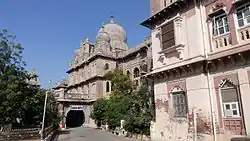Rajmahal, Mehsana
Rajmahal is a palace in Mehsana, Gujarat, India. Built in 1904 by Sayajirao Gaekwad III of Baroda State, it was used as the government office and later as the court until 2017. It has three floors and 130 rooms.
| Rajmahal | |
|---|---|
 Rajmahal from southwest corner | |

| |
| General information | |
| Type | Palace |
| Architectural style | Indo-Saracenic architecture |
| Address | Near old bus station, Rajmahal road, |
| Town or city | Mehsana |
| Country | India |
| Coordinates | 23.608141°N 72.39343°E |
| Current tenants | Vacant |
| Completed | 1904 |
| Closed | 2017 |
| Cost | ₹443,532 (US$6,200) |
| Client | Sayajirao Gaekwad III |
| Owner | Gaekwad family |
| Technical details | |
| Material | Bricks, wood, mortar, stone |
| Floor count | 3 |
| Floor area | 30,322.64 square feet (2,817.065 m2) |
| Design and construction | |
| Architect | Frederick William Stevens |
| Other information | |
| Number of rooms | 130 |
History
Gaekwads conquered Baroda and established Baroda State in 1721. They expanded their rule in north Gujarat and established Patan as its administrative headquarters. Later the headquarters was moved to Kadi and subsequently to Mehsana in 1902 when the city was connected by the Gaekwar's Baroda State Railway which was opened in 1887.[1]
As a public relief during the famine of 1899–1900,[2] Sayajirao Gaekwad III built the palace, Rajmahal, in 1904 (Vikram Samvat 1956) at a cost of ₹443,532 (US$6,200). It was designed by the English architect Frederick William Stevens.[1][3][4] Intended for his son, Fatehsinhrao Gaekwad, who died shortly afterwards in 1908, the palace was then handed over to the municipal authorities.[1] In 1960, when Mehsana was made the district headquarters of Mehsana district, the palace was rented by the Government as the Collector's Office. Later it was used as the district court until 2017.[2][5][6] The palace is unused since and the Gaekwad family is under process in the court to take over its possession. There is a proposal to convert it in a heritage hotel as well as a museum.[7][2]
Architecture
The palace is spread over an area of 30,322.64 square feet (2,817.065 m2). It has three floors and 130 rooms in total; the ground floor with 70 rooms, the first floor with 55 rooms and the second floor with five rooms. The palace is crowned by one large onion-shaped dome, eight small onion-shaped domes and eight small pyramidal domes.[2]
There is a statue of Sayajirao Gaekwad III in the open square in front of the palace.[7]
See also
References
| Wikimedia Commons has media related to Rajmahal, Mehsana. |
- Sergeant, Philip W. (1928). The Ruler of Baroda: An Account of the Life and Work of the Maharaja Gaekwar. Albemarle Street, London: John Murray. pp. 226–229.
- "હેરિટેજ ટુરિઝમ: સરકારની હેરિટેજ પૉલિસીની જાહેરાત, મહેસાણાના ઐતિહાસિક રાજમહેલને મ્યુઝિયમ બનાવવાની રજૂઆત રાજ્યકક્ષાએ પેન્ડિંગ". Divya Bhaskar (in Gujarati). 2020-09-17. Retrieved 2020-11-06.
- Aklekar, Rajendra B. (2017-04-22). "A Sentimental Visit to Mumbai to See Her Great Grandfather's Magnificent Buildings". The Wire. Retrieved 2020-11-06.
court houses at Mehsana for the Gaekwads of Baroda.
- "Journal of the Indian Institute of Architects". Journal of the Indian Institute of Architects. The Indian Institute of Architects: 28. 2003. (Collection of Volume 68, Issue 1 - Volume 69, Issue 12)
- "Mehsana Nagarpalika, Mehsana". Mehsana Nagarpalika (in Gujarati). Archived from the original on 4 November 2016. Retrieved 1 February 2017.
- S. B. Rajyagor, ed. (1975). Gujarat State Gazetteers: Mehsana District. Gujarat State Gazetteers. 5. Directorate of Government Print., Stationery and Publications, Government of Gujarat. p. 805. Archived from the original on 2017-02-16.
- "સયાજીરાવ ગાયકવાડના પ્રપૌત્રે મહેસાણાના રાજમહેલની મુલાકાત લીધી". NavGujarat Samay (in Gujarati). 2018-06-05. Retrieved 2020-11-06.